|
JUNE
2009
�����������������������������������������������������������������������������������������������������������������������������������������������������
30th June 2009 - New research
COMPARISON OF DBS SURGERY
METHODS FOR TREATING PARKINSON'S DISEASE
Around 25% of Annals of
Neurology [2009] 65 (5) : 586-595 (Okun MS, Fernandez HH, Wu SS, Kirsch-Darrow
L, Bowers D, Bova F, Suelter M, Jacobson CE 4th, Wang X, Gordon CW Jr, Zeilman
P, Romrell J, Martin P, Ward H, Rodriguez RL, Foote KD.)
Complete abstract�
Deep Brain Stimulation (DBS)
involves the use of electrodes that are implanted
into the brain and connected to a small electrical device called a pulse
generator that can be externally programmed. DBS can reduce the need for L-dopa
and related drugs. �For
more information go to
Deep
brain stimulation.
The two most common sites in the brain used for Deep Brain Stimulation
(DBS) are the subthalamic nucleus (STN) and the globus pallidus interna.
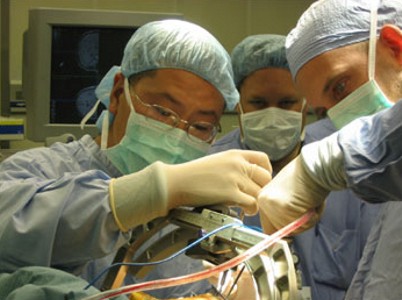 This study compared the effects of the two main
types of DBS. There was no
difference between the two methods in physical movement on the main
Parkinson's Disease score (the UPDRS).
The
effect on mood and intellectual function was similar for both methods. Worsening
of verbal fluency was seen in STN. The deterioration in verbal fluency in the
off STN DBS state was suggestive of a surgical effect rather than due to the
stimulation. Adverse mood effects occurred in both types. The direction of the
surgical method (either optimal, dorsal or ventral) also had effect, as subjects
in both types were less happy, less energetic and more confused when stimulated
ventrally.
In order to refer to this
article on its own
click here. This study compared the effects of the two main
types of DBS. There was no
difference between the two methods in physical movement on the main
Parkinson's Disease score (the UPDRS).
The
effect on mood and intellectual function was similar for both methods. Worsening
of verbal fluency was seen in STN. The deterioration in verbal fluency in the
off STN DBS state was suggestive of a surgical effect rather than due to the
stimulation. Adverse mood effects occurred in both types. The direction of the
surgical method (either optimal, dorsal or ventral) also had effect, as subjects
in both types were less happy, less energetic and more confused when stimulated
ventrally.
In order to refer to this
article on its own
click here.
�
29th June 2009 - New book
PARKINSON'S DISEASE (PERSPECTIVES ON DISEASES
AND DISORDERS)
Carrie Fredericks
 Publisher's
description : These unique anthologies provide accessible information about
diseases and disorders, focusing on controversies and first-person accounts.
Each volume explores a particular disease or disorder in detail, beginning with
an overview chapter that covers symptoms, causes and effects, treatments, cures
and medical advances. The second chapter presents essays on controversies surrounding the disorder, including its causes and
treatments. The final chapter, which contains engaging first-person accounts
from people coping with the disease, provides readers with personal perspectives
on the disease or disorder.
Click here for more details Publisher's
description : These unique anthologies provide accessible information about
diseases and disorders, focusing on controversies and first-person accounts.
Each volume explores a particular disease or disorder in detail, beginning with
an overview chapter that covers symptoms, causes and effects, treatments, cures
and medical advances. The second chapter presents essays on controversies surrounding the disorder, including its causes and
treatments. The final chapter, which contains engaging first-person accounts
from people coping with the disease, provides readers with personal perspectives
on the disease or disorder.
Click here for more details ,
and here for
contents.
For more books concerning Parkinson's Disease go to
Parkinson's Disease Books. ,
and here for
contents.
For more books concerning Parkinson's Disease go to
Parkinson's Disease Books.
�
24th June 2009 - New research
MORTALITY RATES DECLINE IN PARKINSON'S DISEASE
European Journal of
Neurology [2009] Jun 15 [Epub ahead of print] (Mylne AQ, Griffiths C, Rooney C,
Doyle P.)
Complete abstract�
A study carried out in Britain
has shown that mortality rates in
Parkinson's Disease are declining. Mortality rates were assessed by checking for
any mention of Parkinson's Disease on death certificates. The mortality rates
amongst men with Parkinson's
Disease decreased by over 20%. The mortality rates amongst women with
Parkinson's Disease also decreased
by over 20%. Even greater reductions in mortality rates
were
found in older people with Parkinson's Disease.
 The
researchers are unable to ascertain whether the decrease of Parkinson's Disease
recorded on death certificates is because of a reduction in the incidence of
Parkinson's Disease, improved survival due to advancements in Parkinson's
Disease treatments, or to improvements in general medical care. Research earlier
this year showed that
claims of death being much more likely in Parkinson's Disease are greatly
exaggerated. For more information
click here.
After 10 years of Parkinson's Disease, the death
rate actually remained lower than for people without Parkinson's Disease. In order to refer to this
article on its own
click here. The
researchers are unable to ascertain whether the decrease of Parkinson's Disease
recorded on death certificates is because of a reduction in the incidence of
Parkinson's Disease, improved survival due to advancements in Parkinson's
Disease treatments, or to improvements in general medical care. Research earlier
this year showed that
claims of death being much more likely in Parkinson's Disease are greatly
exaggerated. For more information
click here.
After 10 years of Parkinson's Disease, the death
rate actually remained lower than for people without Parkinson's Disease. In order to refer to this
article on its own
click here.
����������������������������������������������������������������������������������������������������������������������������������������������������������������������������� 19th June 2009 - New research
LEWY BODIES FAIL TO INDICATE PARKINSON'S DISEASE
Journal of neuropathology and
experimental neurology [2009] Jun
16. [Epub ahead of print] (Markesbery WR, Jicha GA, Liu H, Schmitt FA.)
Complete abstract�
Lewy bodies are often claimed to be the hallmark of Parkinson's Disease. Lewy
bodies are basically rubbish bins in the nerve cells, that accumulate debris
caused by cell damage. For more information and links go to
Lewy Bodies.
It is claimed that Lewy Bodies can cause Parkinson's Disease by interfering with
the formation of dopamine, and also cause dementia by interfering with the
formation of acetylcholine. So researchers assessed the prevalence of Lewy
Bodies in people that did not have Parkinson's Disease or dementia, by
carrying out autopsies. None of the people assessed had Parkinson's Disease.
However, nearly a quarter of the brains were found to include
Lewy Bodies in various regions of the brain. This finding contradicts the
assertion that Lewy Bodies cause Parkinson's Disease,
because
so many people have Lewy Bodies without having Parkinson's Disease.
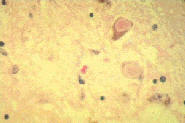 It has also
been previously found that there are many people with Parkinson's Disease that
do not have Lewy Bodies either. The researchers still claimed Lewy Bodies "most likely represents preclinical or pre-symptomatic Parkinson
disease, Parkinson disease with dementia, or dementia with Lewy bodies."
However, their own findings contradict their own suggestion. Rather than Lewy
Bodies cause Parkinson's Disease, the results show that Parkinson's Disease, and
other medical disorders can sometimes cause Lewy Bodies.
In order to refer to this
article on its own
click here. It has also
been previously found that there are many people with Parkinson's Disease that
do not have Lewy Bodies either. The researchers still claimed Lewy Bodies "most likely represents preclinical or pre-symptomatic Parkinson
disease, Parkinson disease with dementia, or dementia with Lewy bodies."
However, their own findings contradict their own suggestion. Rather than Lewy
Bodies cause Parkinson's Disease, the results show that Parkinson's Disease, and
other medical disorders can sometimes cause Lewy Bodies.
In order to refer to this
article on its own
click here.
�
17th June 2009 - New research
COMPARISON OF SCANNING METHODS
FOR DIAGNOSING PARKINSON'S DISEASE
European journal of nuclear
medicine and molecular imaging
[2009] 36 (3) : 454-462 (Eshuis SA, Jager PL, Maguire RP, Jonkman S, Dierckx RA,
Leenders KL.)
Complete abstract�
Around 25% of people with Parkinson's Disease are wrongly diagnosed, due to the
diversity of symptoms and the coincidence with other medical disorders. There
are two methods of scanning the brain that enable the diagnosis of Parkinson's
Disease by measuring the activity of dopamine in the brain : the
SPECT scan and the
PET scan.
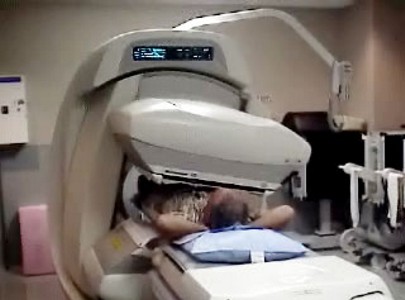 The
aim
of this study was to determine and compare the sensitivity and specificity of
the two methods in the diagnosis of Parkinson's Disease. The patients underwent
both types of brain scan. The SPECT scan and the PET scan were both able to
distinguish people with Parkinson's Disease. For the early phases of Parkinson's
Disease, sensitivity and specificity was 100%. When only one part of the brain
was assessed, the accuracy was still 100% for the SPECT scan, but was 90% for
the PET scan. This level of efficacy makes scanning, especially the
SPECT scan, the most reliable method of diagnosing Parkinson's Disease.�
In order to refer to this
article on its own
click here. The
aim
of this study was to determine and compare the sensitivity and specificity of
the two methods in the diagnosis of Parkinson's Disease. The patients underwent
both types of brain scan. The SPECT scan and the PET scan were both able to
distinguish people with Parkinson's Disease. For the early phases of Parkinson's
Disease, sensitivity and specificity was 100%. When only one part of the brain
was assessed, the accuracy was still 100% for the SPECT scan, but was 90% for
the PET scan. This level of efficacy makes scanning, especially the
SPECT scan, the most reliable method of diagnosing Parkinson's Disease.�
In order to refer to this
article on its own
click here.
�
14th June 2009 - New research
MEMANTINE FOR PARKINSON'S DISEASE
DEMENTIA
Lancet Neurology [2009]
Jun 9 [Epub ahead of print] (Aarsland D, Ballard C, Walker Z, Bostrom F, Alves
G, Kossakowski K, Leroi I, Pozo-Rodriguez F, Minthon L, Londos E.)
Complete abstract�
The biochemistry of Dementia is completely distinct from that of Parkinson's
Disease. However, dementia often occurs alongside Parkinson's Disease.
Researchers tested the safety and efficacy of Memantine (an N-methyl D-aspartate
[NMDA] receptor antagonist) in people with Parkinson's Disease Dementia.
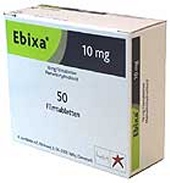 The
primary measure of efficacy
was clinical global impression of
change (CGIC), which is not a precise measure of symptoms. It was concluded that
"Patients with Parkinson's Disease Dementia might benefit from treatment with
memantine, which was well tolerated" but that "Large-scale studies are now
required to confirm" the preliminary findings. However, nearly a quarter of the
participants did not complete the study due to adverse events, the difference in
scores between those people taking Memantine and those taking a placebo was very
marginal, there were no significant differences between the groups in secondary
measures, and no comparison was made of the side effects caused by taking
Memantine.
In order to refer to this
article on its own
click here. The
primary measure of efficacy
was clinical global impression of
change (CGIC), which is not a precise measure of symptoms. It was concluded that
"Patients with Parkinson's Disease Dementia might benefit from treatment with
memantine, which was well tolerated" but that "Large-scale studies are now
required to confirm" the preliminary findings. However, nearly a quarter of the
participants did not complete the study due to adverse events, the difference in
scores between those people taking Memantine and those taking a placebo was very
marginal, there were no significant differences between the groups in secondary
measures, and no comparison was made of the side effects caused by taking
Memantine.
In order to refer to this
article on its own
click here.
�
12th June 2009 - New research
PARKINSON'S DISEASE CAUSES
THINNING OF THE RETINA
Archives of Ophthalmology [2009]
127 (6) : 737-741 (Hajee ME, March WF, Lazzaro DR, Wolintz AH, Shrier EM,
Glazman S, Bodis-Wollner IG.)
Complete abstract�
People with Parkinson's
Disease have been
found to suffer a thinning of the retina. The retina is a light sensitive tissue
lining the inner surface of the eye that is essential for vision. For more
information about the retina go to
Retina.
A study
quantified the thickness
of the retina in people with Parkinson's Disease. No difference was found in
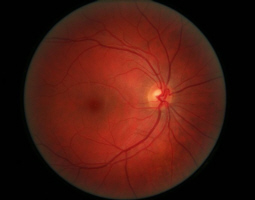 the
thickness of the outer retinal layer in Parkinson's Disease, when compared to
people of the same age that don't have Parkinson's Disease. However, the
thickness of the inner layer of the retina was found to be significantly reduced
in Parkinson's Disease. This lessening of the retina could affect eyesight as
Parkinson's Disease progresses. This effect on the retina may be because
dopamine, whose deficiency causes Parkinson's Disease, besides being produced in
the brain, is also produced in the retina, and so is liable to cause deficiency
symptoms there as well. In order to refer to this
article on its own
click here. the
thickness of the outer retinal layer in Parkinson's Disease, when compared to
people of the same age that don't have Parkinson's Disease. However, the
thickness of the inner layer of the retina was found to be significantly reduced
in Parkinson's Disease. This lessening of the retina could affect eyesight as
Parkinson's Disease progresses. This effect on the retina may be because
dopamine, whose deficiency causes Parkinson's Disease, besides being produced in
the brain, is also produced in the retina, and so is liable to cause deficiency
symptoms there as well. In order to refer to this
article on its own
click here.
�
11th June 2009 - New research
THE PREVALENCE OF GENETIC PARKINSON'S DISEASE
Annals of Human Genetics [2009] May
21
[ahead of print] (Pais�n-Ruiz C, Washecka N, Nath P, Singleton AB, Corder EH.)
Complete abstract�
There are a number of genetic forms of Parkinson's Disease that can incline
somebody towards Parkinson's Disease rather than inevitably cause it. It has
previously been assumed that the number of people with Parkinson's Disease that
are genetically inclined towards developing symptoms in this way was relatively
small. However, researchers have found that
just one of these genetic forms of Parkinson's Disease occurs in a third of
people with Parkinson's Disease. Given that there are other genes that can
incline somebody towards Parkinson's Disease means that the
number
of people genetically inclined towards
Parkinson's Disease is far more than previously thought.
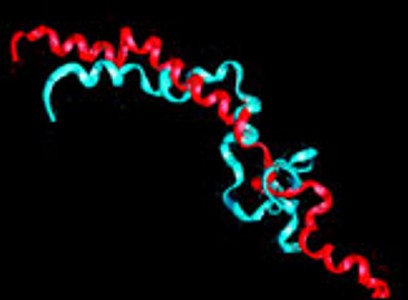 The gene is called
LRRK2 (leucine risk repeat kinase 2), which produces a protein called dardarin,
a word derived from the Basque word dardara, meaning tremor. Mutations in LRRK2
are a common cause of familial Parkinson�s disease. A combination of four gene
variants are found in a third of people with Parkinson�s Disease, but they are
infrequent in the general population. This advance is expected to enable the
identification of people at the greatest risk of Parkinson's Disease before
symptoms arise.
In order to refer to this
article on its own
click here. The gene is called
LRRK2 (leucine risk repeat kinase 2), which produces a protein called dardarin,
a word derived from the Basque word dardara, meaning tremor. Mutations in LRRK2
are a common cause of familial Parkinson�s disease. A combination of four gene
variants are found in a third of people with Parkinson�s Disease, but they are
infrequent in the general population. This advance is expected to enable the
identification of people at the greatest risk of Parkinson's Disease before
symptoms arise.
In order to refer to this
article on its own
click here.
�
6th June 2009 - New review
THE MYTH OF MASSIVE CELL LOSS IN PARKINSON'S
DISEASE
It is widely claimed that there is a massive loss
of the cells involved in Parkinson's Disease (the dopaminergic neurons), and
that the loss of these cells is responsible for causing Parkinson's Disease.
However, not a single study has ever shown this. This false assumption came
about during the 1990's after researchers carried out autopsy studies on people
that had Parkinson's Disease. They mistakenly claimed that they had found a
considerable loss of the cells that produce dopamine. However, their methods did
not even measure cell loss. They measured cell activity
instead.
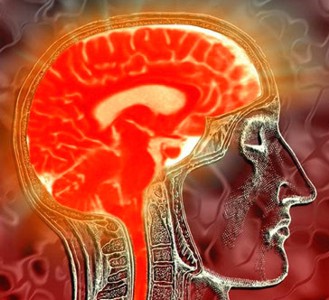 Their results and methods of those of others have shown that, in Parkinson's
Disease, there is a large reduction in the
activity of the dopaminergic neurons rather than a loss of them - down to about
20%-25% in mild Parkinson's Disease, and down to 5%-10% in severe Parkinson's
Disease. There have been subsequent claims of massive cell loss in Parkinson's
Disease. However, those claims have also been based on methods, such as the
f-Dopa PET scan, that only measure cell activity rather than actual cell loss.
Failure to properly scrutinise these studies has enabled the myth of massive
cell loss in Parkinson's Disease to persist and become a prevalent
assumption - even though not a single study has ever shown it to be true.
�In order to refer to this
article on its own
click here. Their results and methods of those of others have shown that, in Parkinson's
Disease, there is a large reduction in the
activity of the dopaminergic neurons rather than a loss of them - down to about
20%-25% in mild Parkinson's Disease, and down to 5%-10% in severe Parkinson's
Disease. There have been subsequent claims of massive cell loss in Parkinson's
Disease. However, those claims have also been based on methods, such as the
f-Dopa PET scan, that only measure cell activity rather than actual cell loss.
Failure to properly scrutinise these studies has enabled the myth of massive
cell loss in Parkinson's Disease to persist and become a prevalent
assumption - even though not a single study has ever shown it to be true.
�In order to refer to this
article on its own
click here.
�
��
|
.gif)
.gif)
 This study compared the effects of the two main
types of DBS. There was no
difference between the two methods in physical movement on the main
Parkinson's Disease score (the UPDRS).
The
effect on mood and intellectual function was similar for both methods. Worsening
of verbal fluency was seen in STN. The deterioration in verbal fluency in the
off STN DBS state was suggestive of a surgical effect rather than due to the
stimulation. Adverse mood effects occurred in both types. The direction of the
surgical method (either optimal, dorsal or ventral) also had effect, as subjects
in both types were less happy, less energetic and more confused when stimulated
ventrally.
In order to refer to this
article on its own
This study compared the effects of the two main
types of DBS. There was no
difference between the two methods in physical movement on the main
Parkinson's Disease score (the UPDRS).
The
effect on mood and intellectual function was similar for both methods. Worsening
of verbal fluency was seen in STN. The deterioration in verbal fluency in the
off STN DBS state was suggestive of a surgical effect rather than due to the
stimulation. Adverse mood effects occurred in both types. The direction of the
surgical method (either optimal, dorsal or ventral) also had effect, as subjects
in both types were less happy, less energetic and more confused when stimulated
ventrally.
In order to refer to this
article on its own
 Publisher's
description : These unique anthologies provide accessible information about
diseases and disorders, focusing on controversies and first-person accounts.
Each volume explores a particular disease or disorder in detail, beginning with
an overview chapter that covers symptoms, causes and effects, treatments, cures
and medical advances. The second chapter presents essays on controversies surrounding the disorder, including its causes and
treatments. The final chapter, which contains engaging first-person accounts
from people coping with the disease, provides readers with personal perspectives
on the disease or disorder.
Publisher's
description : These unique anthologies provide accessible information about
diseases and disorders, focusing on controversies and first-person accounts.
Each volume explores a particular disease or disorder in detail, beginning with
an overview chapter that covers symptoms, causes and effects, treatments, cures
and medical advances. The second chapter presents essays on controversies surrounding the disorder, including its causes and
treatments. The final chapter, which contains engaging first-person accounts
from people coping with the disease, provides readers with personal perspectives
on the disease or disorder.
 The
researchers are unable to ascertain whether the decrease of Parkinson's Disease
recorded on death certificates is because of a reduction in the incidence of
Parkinson's Disease, improved survival due to advancements in Parkinson's
Disease treatments, or to improvements in general medical care. Research earlier
this year showed that
claims of death being much more likely in Parkinson's Disease are greatly
exaggerated. For more information
The
researchers are unable to ascertain whether the decrease of Parkinson's Disease
recorded on death certificates is because of a reduction in the incidence of
Parkinson's Disease, improved survival due to advancements in Parkinson's
Disease treatments, or to improvements in general medical care. Research earlier
this year showed that
claims of death being much more likely in Parkinson's Disease are greatly
exaggerated. For more information
 It has also
been previously found that there are many people with Parkinson's Disease that
do not have Lewy Bodies either. The researchers still claimed Lewy Bodies "most likely represents preclinical or pre-symptomatic Parkinson
disease, Parkinson disease with dementia, or dementia with Lewy bodies."
However, their own findings contradict their own suggestion. Rather than Lewy
Bodies cause Parkinson's Disease, the results show that Parkinson's Disease, and
other medical disorders can sometimes cause Lewy Bodies.
In order to refer to this
article on its own
It has also
been previously found that there are many people with Parkinson's Disease that
do not have Lewy Bodies either. The researchers still claimed Lewy Bodies "most likely represents preclinical or pre-symptomatic Parkinson
disease, Parkinson disease with dementia, or dementia with Lewy bodies."
However, their own findings contradict their own suggestion. Rather than Lewy
Bodies cause Parkinson's Disease, the results show that Parkinson's Disease, and
other medical disorders can sometimes cause Lewy Bodies.
In order to refer to this
article on its own
 The
aim
of this study was to determine and compare the sensitivity and specificity of
the two methods in the diagnosis of Parkinson's Disease. The patients underwent
both types of brain scan. The SPECT scan and the PET scan were both able to
distinguish people with Parkinson's Disease. For the early phases of Parkinson's
Disease, sensitivity and specificity was 100%. When only one part of the brain
was assessed, the accuracy was still 100% for the SPECT scan, but was 90% for
the PET scan. This level of efficacy makes scanning, especially the
SPECT scan, the most reliable method of diagnosing Parkinson's Disease.�
In order to refer to this
article on its own
The
aim
of this study was to determine and compare the sensitivity and specificity of
the two methods in the diagnosis of Parkinson's Disease. The patients underwent
both types of brain scan. The SPECT scan and the PET scan were both able to
distinguish people with Parkinson's Disease. For the early phases of Parkinson's
Disease, sensitivity and specificity was 100%. When only one part of the brain
was assessed, the accuracy was still 100% for the SPECT scan, but was 90% for
the PET scan. This level of efficacy makes scanning, especially the
SPECT scan, the most reliable method of diagnosing Parkinson's Disease.�
In order to refer to this
article on its own
 The
primary measure of efficacy
was clinical global impression of
change (CGIC), which is not a precise measure of symptoms. It was concluded that
"Patients with Parkinson's Disease Dementia might benefit from treatment with
memantine, which was well tolerated" but that "Large-scale studies are now
required to confirm" the preliminary findings. However, nearly a quarter of the
participants did not complete the study due to adverse events, the difference in
scores between those people taking Memantine and those taking a placebo was very
marginal, there were no significant differences between the groups in secondary
measures, and no comparison was made of the side effects caused by taking
Memantine.
In order to refer to this
article on its own
The
primary measure of efficacy
was clinical global impression of
change (CGIC), which is not a precise measure of symptoms. It was concluded that
"Patients with Parkinson's Disease Dementia might benefit from treatment with
memantine, which was well tolerated" but that "Large-scale studies are now
required to confirm" the preliminary findings. However, nearly a quarter of the
participants did not complete the study due to adverse events, the difference in
scores between those people taking Memantine and those taking a placebo was very
marginal, there were no significant differences between the groups in secondary
measures, and no comparison was made of the side effects caused by taking
Memantine.
In order to refer to this
article on its own
 the
thickness of the outer retinal layer in Parkinson's Disease, when compared to
people of the same age that don't have Parkinson's Disease. However, the
thickness of the inner layer of the retina was found to be significantly reduced
in Parkinson's Disease. This lessening of the retina could affect eyesight as
Parkinson's Disease progresses. This effect on the retina may be because
dopamine, whose deficiency causes Parkinson's Disease, besides being produced in
the brain, is also produced in the retina, and so is liable to cause deficiency
symptoms there as well. In order to refer to this
article on its own
the
thickness of the outer retinal layer in Parkinson's Disease, when compared to
people of the same age that don't have Parkinson's Disease. However, the
thickness of the inner layer of the retina was found to be significantly reduced
in Parkinson's Disease. This lessening of the retina could affect eyesight as
Parkinson's Disease progresses. This effect on the retina may be because
dopamine, whose deficiency causes Parkinson's Disease, besides being produced in
the brain, is also produced in the retina, and so is liable to cause deficiency
symptoms there as well. In order to refer to this
article on its own
 The gene is called
LRRK2 (leucine risk repeat kinase 2), which produces a protein called dardarin,
a word derived from the Basque word dardara, meaning tremor. Mutations in LRRK2
are a common cause of familial Parkinson�s disease. A combination of four gene
variants are found in a third of people with Parkinson�s Disease, but they are
infrequent in the general population. This advance is expected to enable the
identification of people at the greatest risk of Parkinson's Disease before
symptoms arise.
In order to refer to this
article on its own
The gene is called
LRRK2 (leucine risk repeat kinase 2), which produces a protein called dardarin,
a word derived from the Basque word dardara, meaning tremor. Mutations in LRRK2
are a common cause of familial Parkinson�s disease. A combination of four gene
variants are found in a third of people with Parkinson�s Disease, but they are
infrequent in the general population. This advance is expected to enable the
identification of people at the greatest risk of Parkinson's Disease before
symptoms arise.
In order to refer to this
article on its own
 Their results and methods of those of others have shown that, in Parkinson's
Disease, there is a large reduction in the
activity of the dopaminergic neurons rather than a loss of them - down to about
20%-25% in mild Parkinson's Disease, and down to 5%-10% in severe Parkinson's
Disease. There have been subsequent claims of massive cell loss in Parkinson's
Disease. However, those claims have also been based on methods, such as the
f-Dopa PET scan, that only measure cell activity rather than actual cell loss.
Failure to properly scrutinise these studies has enabled the myth of massive
cell loss in Parkinson's Disease to persist and become a prevalent
assumption - even though not a single study has ever shown it to be true.
�In order to refer to this
article on its own
Their results and methods of those of others have shown that, in Parkinson's
Disease, there is a large reduction in the
activity of the dopaminergic neurons rather than a loss of them - down to about
20%-25% in mild Parkinson's Disease, and down to 5%-10% in severe Parkinson's
Disease. There have been subsequent claims of massive cell loss in Parkinson's
Disease. However, those claims have also been based on methods, such as the
f-Dopa PET scan, that only measure cell activity rather than actual cell loss.
Failure to properly scrutinise these studies has enabled the myth of massive
cell loss in Parkinson's Disease to persist and become a prevalent
assumption - even though not a single study has ever shown it to be true.
�In order to refer to this
article on its own